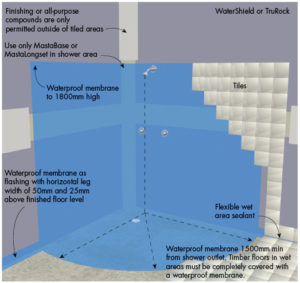Inadequate waterproofing and leakages represent up to 9 out of 10 complaints related to bathrooms. Shower areas are particularly notorious for causing problems, and they require special attention to prevent water and moisture from seeping through the barriers to underlying structures, resulting in costly and disruptive repairs.
Leakages do not only lead to deterioration in the appearance of the shower and surrounding areas, but also result in an unhealthy environment for occupants, cause structural damage to framing, and provide the perfect conditions for mould and mildew to flourish.
When it comes to internal wet areas, prevention is always better than cure and getting the waterproofing right in terms of NCC is critical to long-term enjoyment of these spaces.
Surfaces in the shower area need to be impervious and easy to clean, and also prevent water from penetrating behind linings or into concealed spaces.
Having a fully tiled shower does not adequately address the problem, and will not satisfy the requirements of the Building Code. Ceramic tiles might be waterproof, but cement-based grout is not, and waterproofing under the tiles is, therefore, not negotiable.
Waterproof membrane
To ensure proper waterproofing, a combination of several components is required to achieve a waterproof barrier, including a waterproof membrane, substrate bond breakers, sealants and finishes.
The waterproof membrane is a layer of material impervious to water that is usually applied as a liquid. It must comply with AS/NZS 4858:2004, Wet Area Membranes and be applied according to the manufacturer’s instructions.
Failure of the membrane is the biggest cause of shower leakages. The major causes of membrane failure are:
- No primer or improper installation and curing
- Building movement, such as a timber floor or wall that moves differently to bricks or concrete
The area that needs to be covered by the waterproof membrane depends on two factors:
- Whether the shower is enclosed or unenclosed; and,
- The substrate
Enclosed shower: According to the HIA, an enclosed shower is enclosed by walls or screens and includes a hinged or sliding door that controls the spread of water to within the enclosure.

Unenclosed shower: The shower area is open on one or more sides. A shower fitted with a frameless glass shower screen, or a screen over a bath less than 1500mm long, is considered an unenclosed shower.

The Australian Standard provides clear guidelines regarding the area that needs to be waterproofed in both these structures. In short, waterproofing should not be limited to the shower area, but extend to the floor and the walls right at the floor.
Water resistant substrates
When using a water resistant substrate such as fibre cement or Watershield, Multishield and Trurock, the Building Code of Australia (BCA) and AS3740 requires wet areas to only have a waterproof membrane applied at the wall and floor junctions and at the joints, but this should be regarded as a minimum.
The HIA, Master Builders and BRANZ make no distinction between fibre cement and speciality water resistant plasterboard and recommend installing the membrane over the entire shower.
At Siniat, we take a similar stance: A builder may choose to follow the minimum requirements, or reduce the risk of wet area failures by covering the entire shower area with a waterproof membrane for complete peace of mind.
Choosing the best substrate
Choosing a substrate material that effectively manages water and moisture is the first step to creating a bathroom that will remain waterproof for many years to come. Surface finishes such as ceramic and porcelain tiles also require a stable, flat and flex-free substrate.
Siniat offers various speciality solutions for internal wet areas:
- Watershield is a water-resistant plasterboard suitable for use in most internal wet areas and the perfect substrate for tiles.
- For high-rise buildings and apartment blocks, Multishield offers the combined benefits and properties of water and mould resistance.
- If the shower is located in an area where high traffic is expected, such as public bathroom facilities or in a gym, impact resistant Trurock is an excellent choice. Trurock HD takes it even one step further and offers the added benefit of mould resistance and enhanced impact performance.
Choosing the best sealant
Waterproofing is a very black and white area: a room is either waterproof or it is not. Even the slightest crack or cavity can jeopardise all your efforts to prevent water from penetrating the underlying structures.
Choosing the best compounds for jointing and the final touches is, therefore, as important as all the other steps of creating a waterproof system.
Siniat recommends using Mastabase or Mastalongset for all plasterboard joints, corners and fastener heads.
When it comes to waterproofing the shower, there are no shortcuts. By using the best practice techniques and the best materials during the installation process, you can save yourself many headaches down the line.

